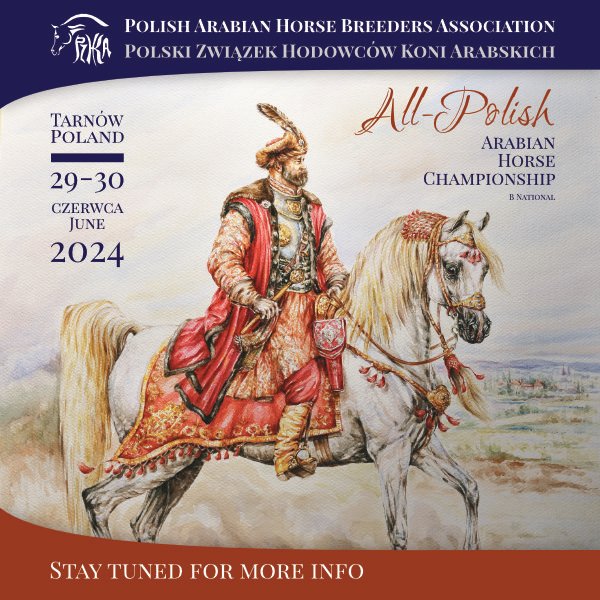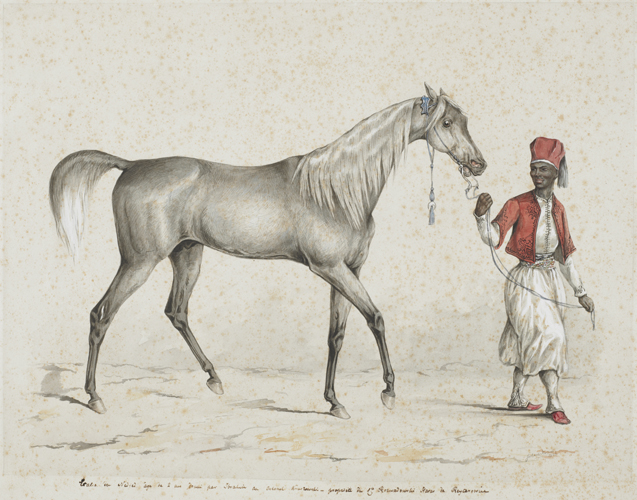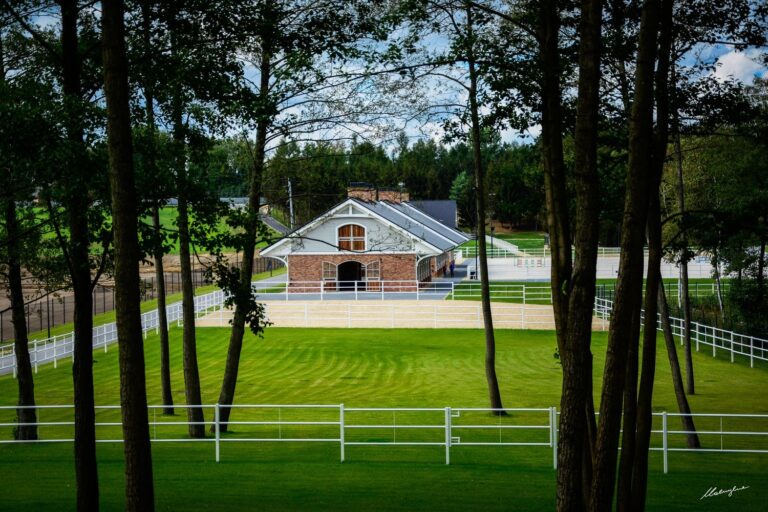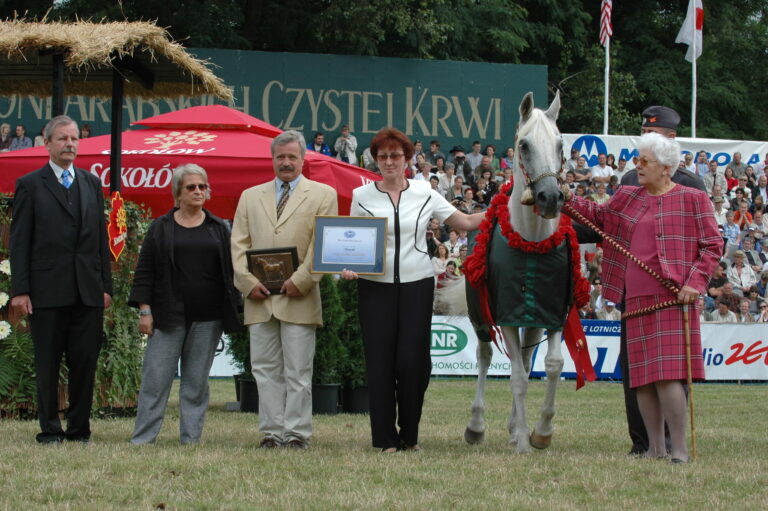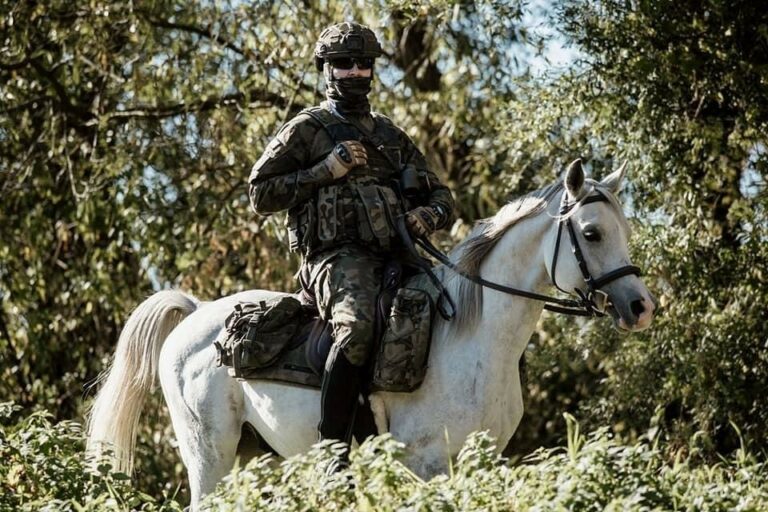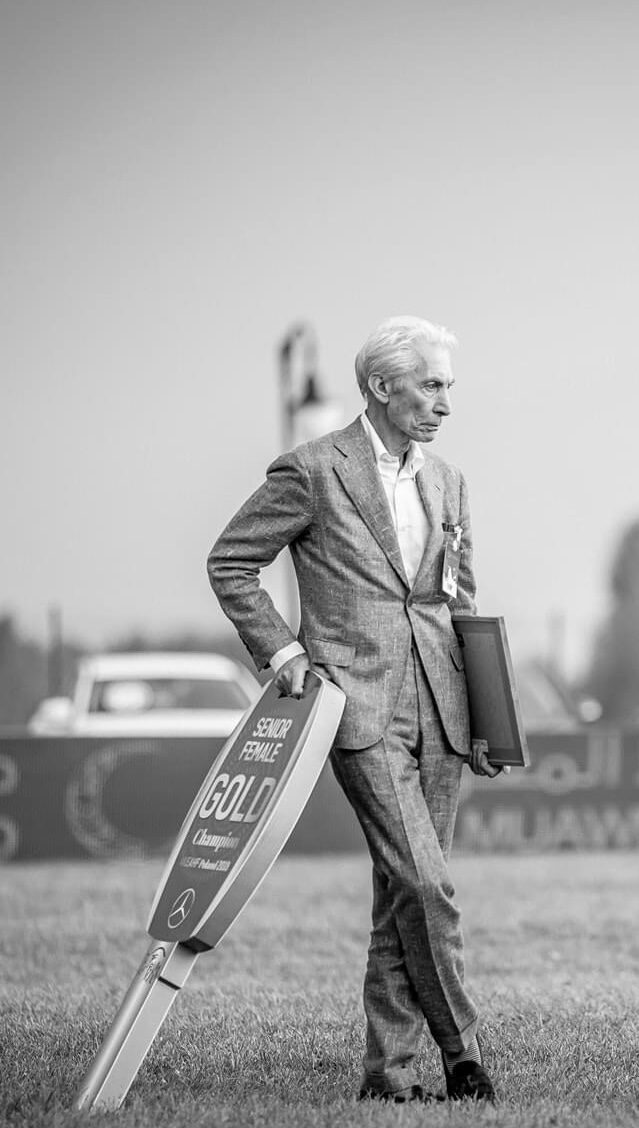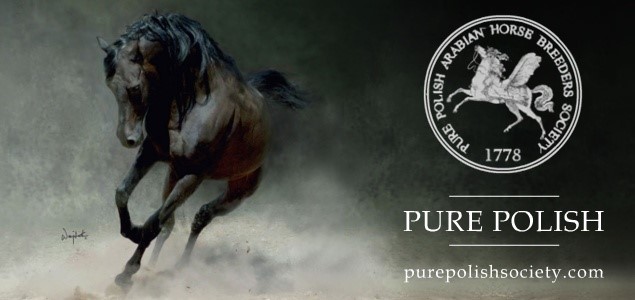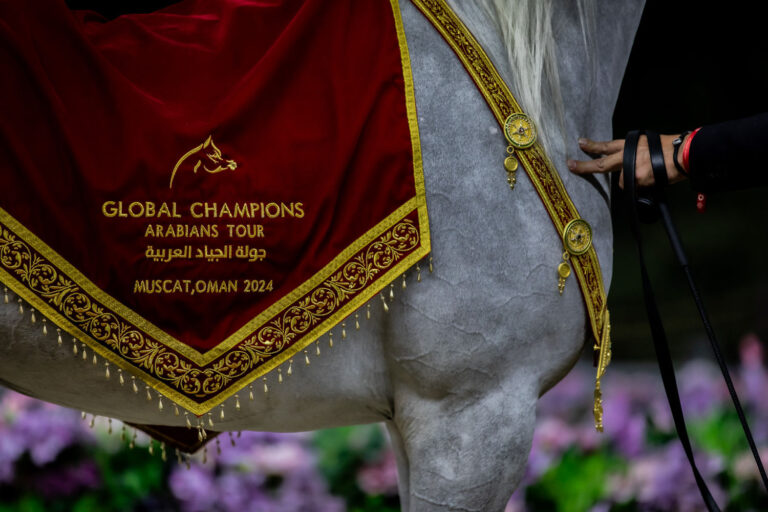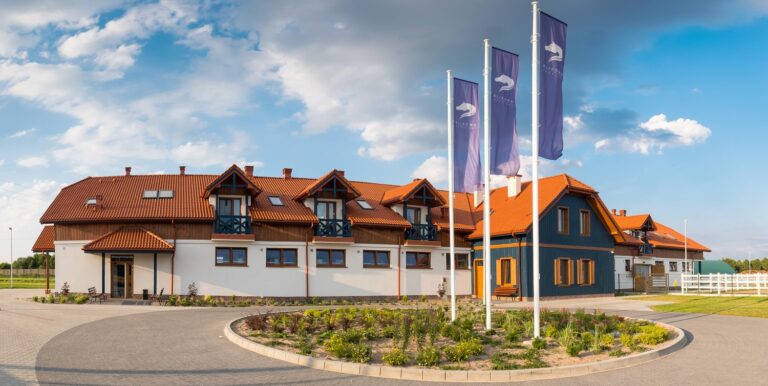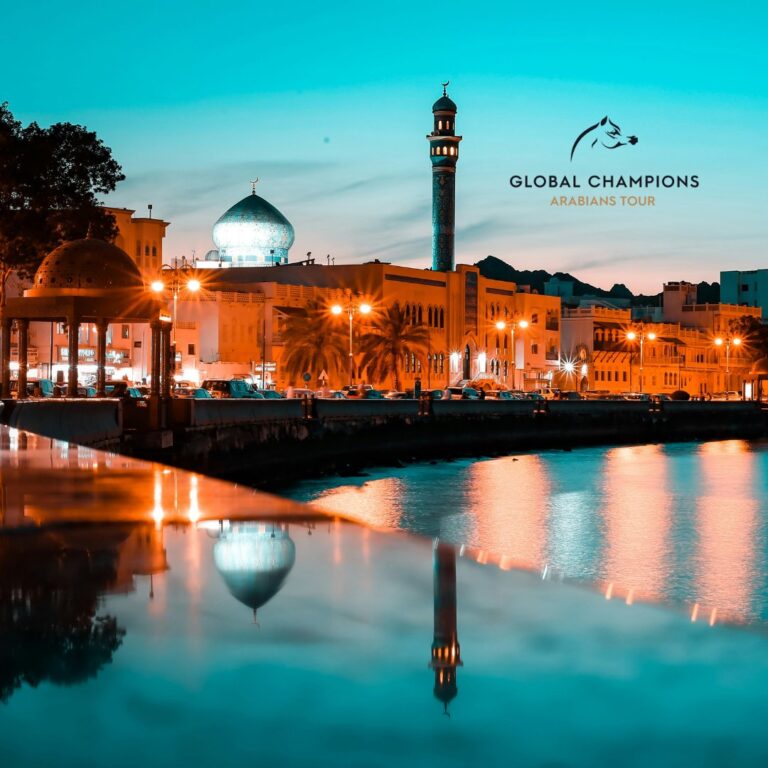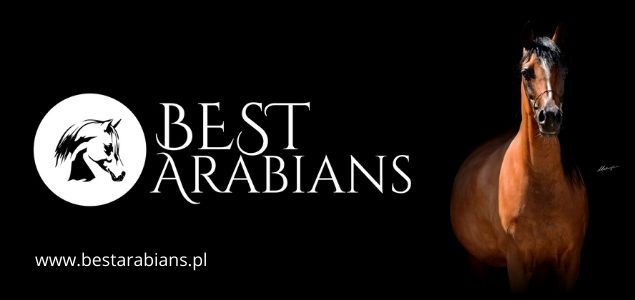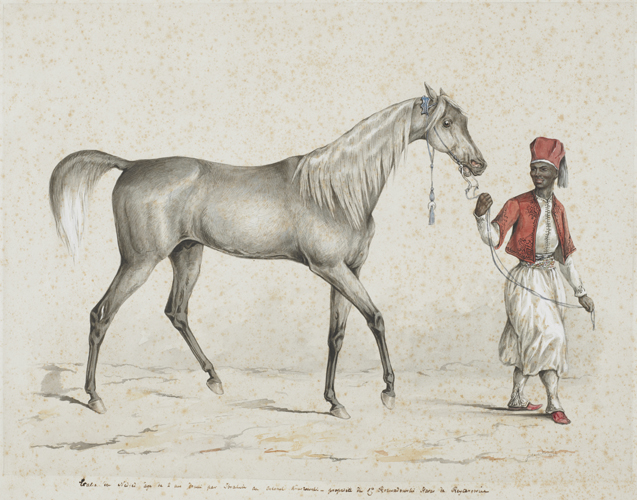
The horse, man’s companion for centuries widely used for farm work, transport and traveling, was an object of interest for artists, though usually not the leading motif. In Polish painting this changed due to JULIUSZ KOSSAK (1824–1899). Who knows if that would’ve happened if the painter did not come across Arabian horses. Honoré de Balzac distinguished three synonyms of beauty: une jolie femme qui dance (a beautiful lady dancing); un pur sang en libérté (a pure blood steed set free); une frégate sous voiles (a frigate under full sail). The second aesthetic model became an artistic trademark of Kossak, the progenitor of a clan which rendered great services for Polish culture.
A carriage – a catalyst for labor
On October 29th, 1824, Juliusz Kossak was born in a small town Nowy Wiśnicz. Why there? Because his careless pregnant mother decided to leave the Kniahinin settlement by the upper San River and travel to Cracow. The journey by a four-horse carriage over bumpy roads of the Podkarpacie region quickened the delivery. Fortunately, the group was passing by Wiśnicz. A folk healer was called, soon joined by a medic who arrived on horseback and delivered the newborn. After some dozen hours, when the mother recovered, she returned with the baby to her home estate to have him baptized. This was done in a Uniate church by a pope, because the Kossaks treated Ruthenians like Poles, not differentiating between Roman Catholicism and its Greek variety. Due to this approach the young boy learned Polish and Ukrainian equally since his early years.
His blissful childhood was cut short by the death of his father, a judge, in Lvov. His mother took to raising five children, as Juliusz had two sisters and two brothers. Leon Kossak, after his exile to Siberia for participating in the January Uprising (1863), also became known as a painter specializing in battles. Władysław – a participant of the Spring of Nations (1848) in Hungary, landed in Australia, where he settled down, established a family and gave rise to the Australian branch of the Kossak family, whose descendants live there till this day.
Dead models
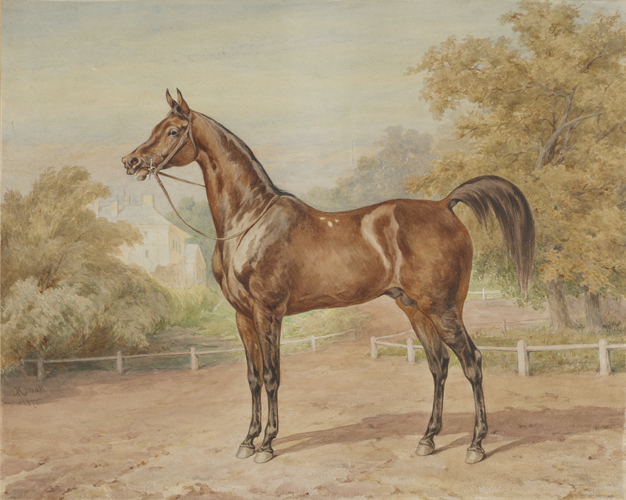
Already during his school days (the Lvov education center of the Basilian Order) Juliusz displayed a talent for art. Portraits of his classmates brought him respect among his peers, whereas the caricatures of the teaching staff often ended with penalties such as standing in a corner, kneeling on peas or even corporal punishment, probably “applied by the teacher by rhythmically hitting the culprit’s hands with a ruler”, as Wiktor Gomulicki* described the 19th century pedagogical sanctions in “The memories of the jolly uniform” (1906). Hurtful blows to his hands did not however discourage the insubordinate student from reaching for pencils and coal (he used these techniques during his early years). He had his first artistic success at the age of 15, after drawing a portrait of his classmate’s sister, an 18 year old ready for marriage. Pleased with her image, she went with our artist in spe on a date and allowed herself to be kissed!
Juliusz did not abandon his interest in art even when starting law at the John II Casimir University in Lvov upon the strict orders of his mother. However instead of learning ancient Roman maxims by heart and listening to juridical lectures he preferred to visit urban slaughterhouses (!). He sketched the anatomy of animals, mainly horses, which he later showed to his – as well as Artur Grottger’s – painting mentor, Jan Maszkowski (1793–1865). Years later he told Stanisław Witkiewicz**: “It was in such gruesome setting that I learned to precisely recreate all elements of the horse’s conformation”. Supposedly he was not aware at the time that this four-legged model would give him immortal fame. Although 117 years have passed since Juliusz’s death, he is still the number one equine portraitist in Poland.
Borderland clans
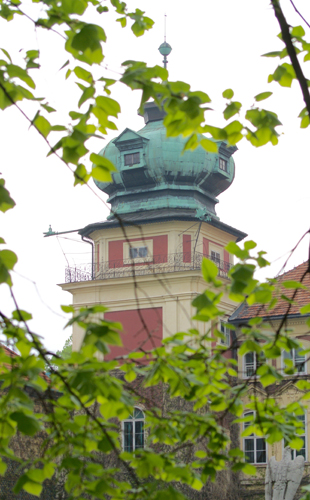
Bored with law, he abandoned his studies, broke ties with his family that did not accept this decision and began to live on his own. He earned his keep with his brush, supposedly of horse hair. He wandered with his palette from manor to manor of Volhynia, Podolia and Pokucie. Beside a humble remuneration – for the paintings of noblemen, dogs, horses, settlements and landscapes – he received meals and a roof above his head.
The daredevil fame of the arrogant artist swelled thanks to protection. As Stefania Krzysztofowicz-Kozakowska writes (“The Kossaks”), in 1844 Juliusz was invited by Alfred Potocki for a great par force hunt in Łańcut. He illustrated it a year later. The same year also brought the creations of “The grey mare Szaytanka” and “An Arabian stallion with a Bedouin”. His stay at Łańcut resulted in further connections. Kazimierz Dzieduszycki from Niesłuchowo acquainted Juliusz with Władysław Rozwadowski from Rajtarowice, who directed the young man to Medyka, managed by Jan Gwalbert Pawlikowski, who in turn introduced him to Leon Rzewuski from Podhorce. Everyone liked him not only due to his artistic talents, but also for social ones. Juliusz turned out to be an excellent companion for hunts and parties.
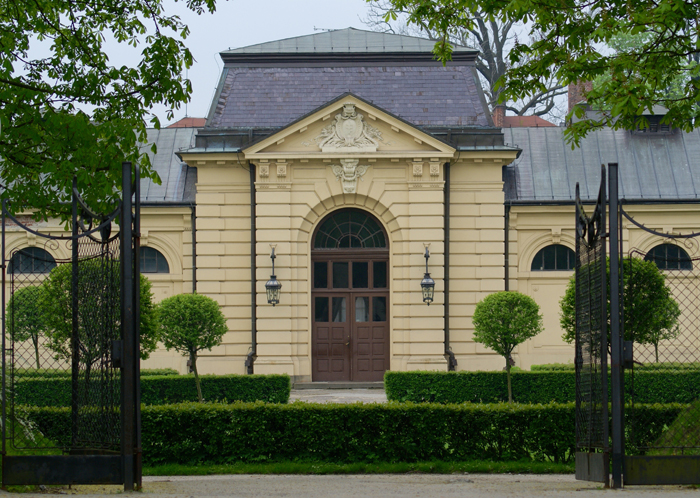
Landlords invited him over readily. They even tried to put together a scholarship for his foreign painting studies, but the collected amount was too small. Fortunately it was then that Piotr Michałowski (1800–1855) returned to his homely Bolestraszyce. Seeing that the young man’s works were promising, he decided to give Juliusz some painting lessons.
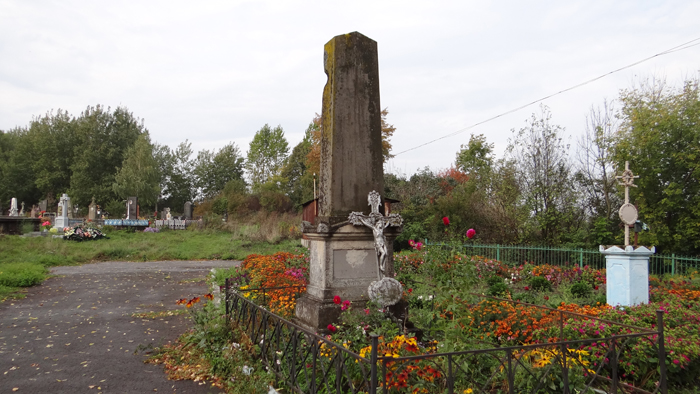
But who knows whether horses would dominate Juliusz’s output if not for the Dzieduszycki family. An expanded clan of the borderlands, with great services to Poland and many large estates under their management, which – as Roman Aftanazy put it – “its hobbyhorse were Arabians”. The pride of their stable in Jarczowce were pure bred equines (usually worth a fortune), imported mainly from Asia Minor. But it was not an investment, more the satisfying of their desires.
Stable Latin
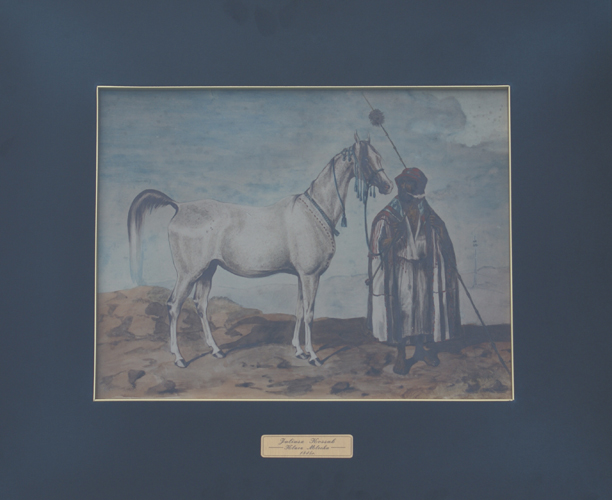
In 1845 the vagabond and eccentric Juliusz Dzieduszycki*** imported a herd of Arabians purchased from the Bedouins, among them broodmares that have made history – Mlecha, Gazella and Sahara. They were placed in a barn adjacent to the living room, whose walls were covered in crystal mirrors and the floors in Persian rugs. From time to time he visited Lvov in order to “civilize” himself. Once he was sitting in the local bath house, listening to students talking. One of them said: “It’s a pity Juliusz isn’t here with us, he’d paint us nicely…”. Another answered, that Juliusz only paints horses. At the time Kossak was 21 years old and so his great career began: for immortalizing his herd on canvas Dzieduszycki gave Juliusz a roof over his head and paid him a salary.
Both men were linked by friendship and temperament. “They lived as genuine Epicureans. Tired after daylong riding in the saddle Dzieduszycki would lie down in the stable on a rug and read classic Latin. He especially liked Horace’s «Odes». Carpe diem! – this was a pleasant sense of life (…) In the evening friends and family arrived, as well as other company. They drank excellent wine, talked about horses and women, only later about politics, joked about one another… During this time the manor staff were already giving thorough baths to girls from villages, which were to share the bed with the «lords» through the night. There was never a lack of such «volunteers», as the girls received remuneration for their affection from the generous lords. At dawn the temporary lovers returned to their shabby cottages, delighted with the splendor and happy for several coins, which were usually eagerly awaited by fathers, brothers and even husbands”, wrote Aleksander Piskor in “Seven excellencies and one lady”.
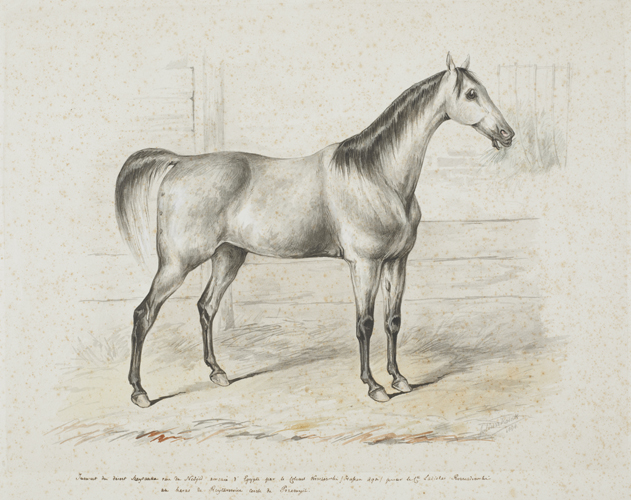
Dzieduszycki, a would-be doctor, turned Kossak’s attention to equine anatomy. Only when the young painter learned it thoroughly, the steeds on his canvases became alive and soon even started literally coming out of the frames. Was this due to both Juliusz’ visits at the Lvov race track? In 1845 they witnessed – as chronicler Józef Skarbek-Borowski wrote – a “terrible tragedy” there. “Whether the meeting was so large in numbers, or the sportsmen required so much to drink in the summer heat? The fact is, written down in the town’s chronicles, that Lvov ran out of champagne wine! (…) Horsemen were sent out to manor houses to drain wine cellars and save the town from a terrible drought…”.
The Galician Slaughter of Jakub Szela (1846), the Cracow Uprising of Edward Dembowski (1846) and then the Spring of Nations**** ended the carefree time of the painter’s life. It was not until three decades later that he made a sentimental journey across the East Galician province, whose landscape despite the abolition of serfdom and industrial development changed little. The steppes still had herds of horses galloping across them. Including their most beautiful version, Arabian.
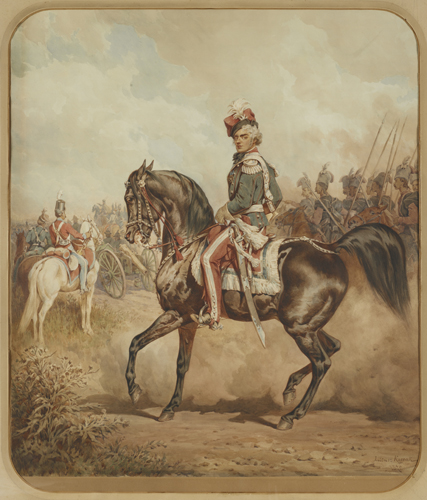
Kossak, who was guided through the painting world by Piotr Michałowski, also a stud owner, initially made watercolors. After acquiring painting knowledge – hours spent in galleries of St. Petersburg, travels to Hungary and Vienna and thorough painting studies in Paris, where he found a mentor and friend in the shape of Horace Vernet (1789–1863), brilliant painter of battle scenes, did much to help – he began using oil paints. But before that Kossak tasted other illustration techniques. He discovered daguerreotype, as photography was called upon its invention. In order to refine the first photos they were painted over on a mass scale. And that’s what the future “Uhlan with a brush”, as General Bolesław Wieniawa-Długoszowski called him, started doing, in the Warsaw workshop of Józef Giwartowski. It was not the only source of keep for Juliusz. He added to his income as an illustrator of books, as well as newspapers: “Kłosy”, “Przegląd Tygodniowy”, “Przyjaciel dzieci”. Several years spent in the Warsaw streets resulted in connections with students of the Academy of Fine Arts: brothers Maksymilian and Aleksander Gierymski, Józef Brandt, Henryk Siemiradzki. He continued his acquaintances later in Munich pubs, leading long discussions there after lessons with Franz Adam, a lecturer in the painting Mecca of the second half of the 19th century, the Bavarian Academy of Fine Arts.
After the January Uprising, wishing to avoid educating his children in schools Russified by the tsarist invader, he moved with his family to Cracow. They settled down in a manor known over time as the Kossakówka, whose threshold was often crossed by such huge names of Polish culture as Adam Asnyk, Stefan Żeromski, Stanisław Witkiewicz, Henryk Sienkiewicz, Teofil Lenartowicz, Henryk Rodakowski, Józef Chełmoński, Wojciech Gerson, Jan Matejko, Jacek Malczewski.
Leitmotif on four hooves
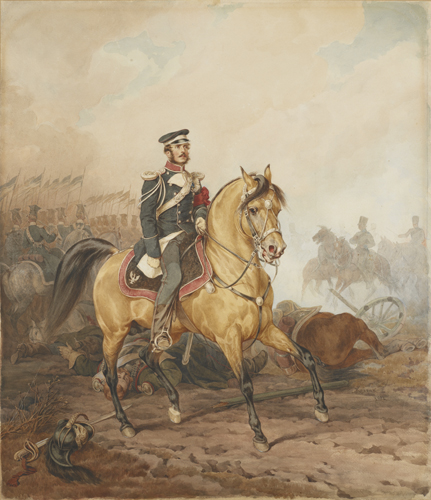
Horses are a symbol of the output of Juliusz Kossak (his son Wojciech and grandson Jerzy also; the latter, according to his daughter, sometimes copied the works of his ancestors). Steeds were present in genre, lifestyle, historic and battle scenes, portraits of aristocracy and landlords (the Fredro, Gniewosz, Tyszkiewicz, Branicki, Lipski, Morstin, Potocki, Sanguszko families). He was often a guest in the most famous Arabian studs of his time: Sławuta, Jarczowce, Gumniska, Biała Cerkiew, Janiszówka and Uzin. Their inhabitants became a Kossak trademark. A very precise one at that, proof of which is the gallery of Arabian steeds – the pride and joy of the studs by the Bug River: “Chestnut horse Carogród”, “Grey Arabian stallion Obejan”, “Horse Oleś”, “Grey mare Gulda” or perhaps the most famous “Farys”.
A stallion with a stripe on his forehead and white socks jumps over an equine skeleton lying on a desert shrouded in the darkness of the night. He is carrying a rider clad in a jellabiya, poised to shoot from a bow. The pursuit, that we can only guess is there, is not the only danger. The barren landscape is diversified by vultures circling in the sky and clouds of dust heralding a sand storm.
The watercolor was created in 1881, inspired by a poem of Adam Mickiewicz*****, “Faris, a qasida in honor of Emir Tadż-ul-Fechra, dedicated to Jan Kozlov” (1828). The poet dedicated this piece to Count Wacław Rzewuski, who in 1817 with a retinue of Kossacks and accompanied by a doctor, secretary, translator and veterinarian set off for an oriental expedition in search of pure bred Arabian horses. He wanted to divide them among the studs of tsar Alexander I, the queen of Württemberg and his own, in Sawrań in the Podole region. The expedition, leading through the Balkans and Constantinople, reached Aleppo. From there it headed for Lebanon, Syria, Jordan, to arrive at the Arabian Peninsula after many dangerous adventures and funny situations. Rzewuski gained the trust and in the end friendship of leaders of many Bedouin tribes. He even participated in their war expeditions. The Bedouins gave him the honorable title of Tadż Fahr Abd el Nischaane (“Wreath of Fame”) and led him to the cradle of the breed, where no European had set foot. The count purchased a herd of more than a hundred horses and managed to bring most of them to the Ruthenian steppes. This herd was a cornerstone of Polish Arabian horse breeding, which quickly became our trademark. Juliusz Kossak followed its development closely, documenting its subsequent stages with the aid of his palette and easel.
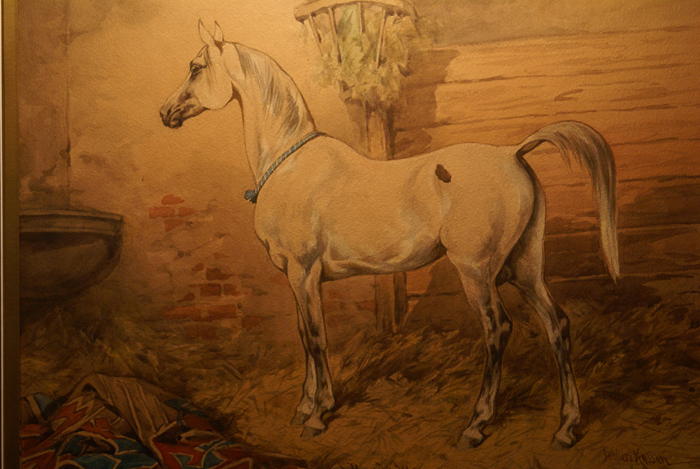
Another of the artist’s superb canvases depicts the stallion Bagdad. As Stefan Bojanowski wrote in 1904 in “Profiles of Oriental Horses and Their Breeders”): “In order to make the purchase Juliusz received a full purse of ducats in gold from his father, took all of his own money and went to Lvov by carriage, drawn by a team of four horses. Having looked upon Bagdad he became so enthusiastic that he not only gave all the ducats he received from his father and those which he took from his own coffers (and it is said that there was quite a lot in there) for the steed, but also sold the four carriage horses, the carriage itself, the rugs and a whip richly fitted in silver to gather the demanded sum for the horse. He travelled back to Jarczowce atop Bagdad, while the coachman returned home on foot”. Bagdad’s son, Pielgrzym 1851 (out of Gazella d.b.) was sold to Babolna, where his name was changed to Bagdady. And such a caption can be found on this painting, but is said not to be reflecting the truth. Considering that the painter spent his time in Jarczowce in the 40s of the 19th century, the same period that Bagdad was there, as well as the fact that in the last decade of his life (as told by Kossak’s biographer Kazimierz Olszański in the book “Juliusz Kossak”) the artist painted from memory, repeating previous motifs, it can be presumed that the painting, today in the hands of a private collector, indeed shows the stallion Bagdad.
The legacy of Juliusz is a huge, collective picture of the greatness and beauty of the culture of knights and noblemen. And – not less important – of equine Poland.
From under hammer to up on walls
The quality of the technique used in Kossak’s works and their patriotic impact brought the artist esteem and splendor still during his life (which isn’t all that common). And commissioned equine paintings brought him a fortune. The Kossakówka became the place to be for the artistic elite of Cracow and Galicia. Whereas the ambition of many new-rich was to hang Juliusz’s equine watercolor in the living room or study. Just like today.
Horse scenes and battle compositions of Juliusz Kossak invariably continue to thrill collectors. Since the very first art auctions they are priced high. “Farys” was bid at Agra from its 39 thousand PLN asking price to 50 thousand and the “Zaprzęg czterokonny” (Four-horse drawn carriage, 41×79,5), years earlier the pride of the collection of Entailer Wilhelm Siemieński-Lewicki, achieved 70 thousand PLN (from the 60 thousand asking price).
———————————————–
*Wiktor Gomulicki (1848–1919), Polish poet, writer, investigator of the history of Warsaw.
**Stanisław Witkiewicz (1851–1915), Polish painter, architect, writer and art theorist.
***Count Juliusz Dzieduszycki (1817–1885), land owner, horseman. In 1840 he set off on a famous, full of adventures expedition to Lvov to acquire the stallion Bagdad and in 1845 to Arabia, from where he brought the mares Gazella, Mlecha and Sahara. Their significance for Polish Arabian horse breeding does not need to be emphasized. This stud, similar to the others, did not survive. The only ones to survive the extermination of the World War I and the Bolshevik invasion in the years 1917–1918 were the mare Pomponia 1902 and three fillies, which sent to Janów formed the foundations of the stud (Gazella II 1914, Mlecha 1914 and Zulejma 1914). Descending from Pomponia and Zulejma was the epochal Ofir.
****Galician Slaughter – a peasant uprising on the lands of western Galicia in the second half of February and March of 1846, of an anti-noblemen and anti-serfdom nature. Jakub Szela was the most known leader of the peasant units. Cracow Uprising – an attempt at an all-Polish uprising in the name of democracy. The Spring of Nations – a series of revolutionary and national uprisings in Europe during 1848–1849.
*****Adam Mickiewicz (1798–1855), romantic poet, author of the Polish national epic „Pan Tadeusz”.
Read more:
Bagdad – a stallion that became part of a legend
I chose my own land, freedom and horses
Jarczowce. Tracking down Mlecha, Gazella and Sahara
Who was Gliocco, the seller of Bagdad
Download the PDF version of the article»


